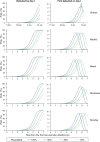Feasibility of wastewater-based detection of emergent pandemics through a global network of airports
- PMID: 38478549
- PMCID: PMC10936834
- DOI: 10.1371/journal.pgph.0003010
Feasibility of wastewater-based detection of emergent pandemics through a global network of airports
Abstract
Wastewater-based surveillance has been put into practice during the pandemic. Persistence of SARS-CoV-2 in faeces of infected individuals, and high volume of passengers travelling by air, make it possible to detect virus from aircraft wastewater, lending itself to the potential identification of a novel pathogen prior to clinical diagnosis. In this study, we estimated the likelihood of detecting the virus through aircraft wastewater from the probabilities of air travel, viral shedding, defecation, testing sensitivity, and sampling. We considered various hypothetical scenarios, with diverse sampling proportions of inbound flights, surveillance airports, and sources of outbreaks. Our calculations showed that the probability of detecting SARS-CoV-2 would increase exponentially against time in the early phase of the pandemic, and would be much higher if the 20 major airports in Asia, Europe, and North America cooperated to perform aircraft wastewater surveillance. We also found other contributors to early detection, including high sampling proportion of inbound flight at destination airports, small population size of the epicentre relative to the travel volume, and large volume of outbound travelers to major airports around the globe. We concluded that routine aircraft wastewater monitoring could be a feasible approach for early identification and tracking of an emerging pathogen with high faecal shedding rates, particularly when implemented through a global surveillance network of major airports.
Copyright: © 2024 Jin et al. This is an open access article distributed under the terms of the Creative Commons Attribution License, which permits unrestricted use, distribution, and reproduction in any medium, provided the original author and source are credited.
Conflict of interest statement
I have read the journal’s policy and the authors of this manuscript have the following competing interests: Kai Yee Toh is salaried employee of AMILI Pte Ltd.
Figures





Similar articles
-
Establishing a European wastewater pathogen monitoring network employing aviation samples: a proof of concept.Hum Genomics. 2025 Mar 11;19(1):24. doi: 10.1186/s40246-025-00725-w. Hum Genomics. 2025. PMID: 40069832 Free PMC article. Review.
-
Suitability of aircraft wastewater for pathogen detection and public health surveillance.Sci Total Environ. 2023 Jan 15;856(Pt 2):159162. doi: 10.1016/j.scitotenv.2022.159162. Epub 2022 Oct 3. Sci Total Environ. 2023. PMID: 36202356 Free PMC article.
-
A global aircraft-based wastewater genomic surveillance network for early warning of future pandemics.Lancet Glob Health. 2023 May;11(5):e791-e795. doi: 10.1016/S2214-109X(23)00129-8. Lancet Glob Health. 2023. PMID: 37061316 Free PMC article. Review.
-
Estimating COVID-19 outbreak risk through air travel.J Travel Med. 2020 Aug 20;27(5):taaa093. doi: 10.1093/jtm/taaa093. J Travel Med. 2020. PMID: 32502274 Free PMC article.
-
Detection of SARS-CoV-2 RNA in commercial passenger aircraft and cruise ship wastewater: a surveillance tool for assessing the presence of COVID-19 infected travellers.J Travel Med. 2020 Aug 20;27(5):taaa116. doi: 10.1093/jtm/taaa116. J Travel Med. 2020. PMID: 32662867 Free PMC article.
Cited by
-
Establishing a European wastewater pathogen monitoring network employing aviation samples: a proof of concept.Hum Genomics. 2025 Mar 11;19(1):24. doi: 10.1186/s40246-025-00725-w. Hum Genomics. 2025. PMID: 40069832 Free PMC article. Review.
References
-
- Jones DL, Baluja MQ, Graham DW, Corbishley A, McDonald JE, Malham SK, et al.. Shedding of SARS-CoV-2 in feces and urine and its potential role in person-to-person transmission and the environment-based spread of COVID-19. Sci Total Environ. 2020;749: 141364. doi: 10.1016/j.scitotenv.2020.141364 - DOI - PMC - PubMed
LinkOut - more resources
Full Text Sources
Miscellaneous
